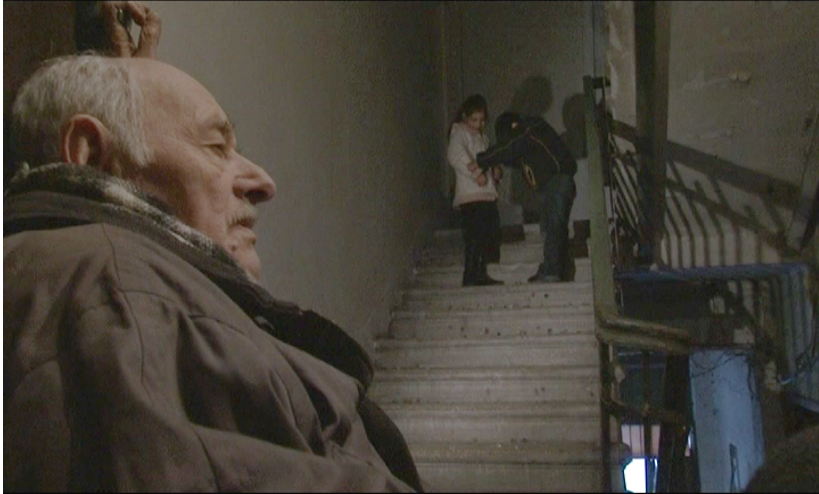Human isolation has its own language – a form of dialogue between the mind and the outside world, both silent and destructively noisy, suffocating for human identity. Salome Vepkhvadze’s student film, “Me, They and Daddy” (2014), skillfully addresses this language and draws the viewer into the main characters', a 12-year-old girl and her mentally ill father. The film won the main award for best foreign language feature film at the International Student Film Festival in Sofia, Bulgaria. One of the main roles in the film is played by the director’s father, Vladimir Vepkhvadze, while the 12-year-old girl (Gvantsa Darsania) was selected by the film crew through casting. It is amazing, although the film is technically and content-wise well-made, and the actors' acting is natural, which is usually less typical of student films.
The plot begins mystically, almost surrealistically and despite the limited time (the running time is only about 16 minutes), the viewer is immediately aware of the close relationship and strong bond between father and daughter, in which the father's mental illness has caused cracks. It is noteworthy that for quite a long time after the film begins, the viewer's consciousness is struck by the idea that the imaginary world of father and daughter and their unusual integration with each other are part of the real, physical world. This is also one of the most remarkable aspects of the film – the blurring of the boundary between reality and imagination. The first part develops in such a way that the director manipulates the viewer – for a moment he makes us believe that the heroes of the story and their imaginary “enemies” do not belong to some invented metaphysical dimension and that the viewer simply does not have the ability to perceive what the characters see. Only in the final part does it become clear that the father is mentally ill and that the daughter is forcibly, deliberately participating in her father’s “imaginary game” just so as not to make him feel even more miserable.
In order to make their work more poetic and valuable and, at the same time, to create a specific atmosphere for the film, filmmakers often avoid giving much space to dialogue. It is interesting to see whether the director has avoided this difficult work, which is called the art of dialogue, although it must be said that the minimal use of verbal communication in this film ultimately had a positive effect on creating a kind of mystical atmosphere in the film. In addition, the lack of dialogues better demonstrated, on the one hand, the alienation and emotional distance that the father's mental state created between the family members (mental illness, after all, can cause a rift between father and daughter. The existing closeness and sense of familiarity were killed), and on the other hand, the language of silence better conveyed the strong bond between the characters, which mental illness cannot completely destroy.
The main characters are completely isolated from the outside world. This isolation is not only physical, but, first of all, it expresses the isolating nature of mental illness, which leaves the person completely alone, closed, without identity, cut off from the real world and everyone, alienated, deprived of the understanding and support of others.
The events that unfold in the first part create a feeling of uncertainty in the viewer about what is real and what is not. This uncertainty and confusion coincide with the emotional state and internal struggle of a 12-year-old girl, who, like her father (not as severely, but still), has begun to lose touch with reality. Therefore, the decision to send father to a psychiatric institution can, on the one hand, be considered an expression of the daughter’s attempt to save herself, but if we take into account the strong, close family bond between father and daughter and the girl’s tireless efforts to make the only person dear to her feel better, which we witness throughout the film, it would be more correct to conclude that the daughter’s decision to send her father to a psychiatric institution is an expression of the girl’s love and care for her father.
The title of the film is worth mentioning separately – “Me, They and Daddy,” which captures the viewer’s attention from the very beginning. If we take into account the fact that the father and daughter live in isolation from those around them, “Them” represents an imaginary, invisible threat characteristic of the father’s paranoia and illness, which has built a wall between the characters.
Mental illness is one of the most stigmatized issues in Georgia. In our country, people often do not consult a specialist for various reasons – fear of judgment from society or shame – and avoid treatment as much as possible, until the mental health problem takes on its most complex form. An incurable mental condition has a detrimental effect not only on the patient, but also on those around them. The plot line in Salome Vepkhvadze's film also develops in the same way – a girl makes the difficult decision to send her father to a psychiatric institution, but she takes this step only after the character's life is in danger. The director gives us a hint about this at the very beginning of the film, by showing a healed wound on the father's arm. In the final scene, the black door closes. This makes it clear to the viewer that the connecting thread between the girl and her father, which the daughter tried to maintain in every way, has finally been broken. Despite the sad ending of the film (the father goes to the psychiatrist without looking back, and the rain reinforces this mood), it is also possible to see a ray of hope in it – the rain symbolizes a new beginning. The sacrifice made by the girl is necessary on the path to healing her father.
Nato Mtsariashvili






